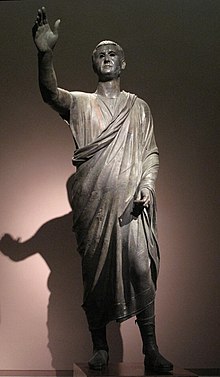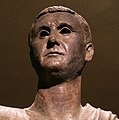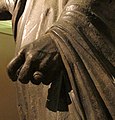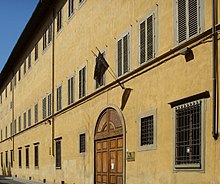Arringatore
The Arringatore ( Italian: the speaker) is an Etruscan bronze statue from the late 2nd century BC. BC or early 1st century BC And represents Aule Meteli or Metele (Latinized Aulus Metellus or Metellius). The sculpture was discovered in the 16th century and is now in the National Archaeological Museum of Florence . The statue is a significant example of late Etruscan bronze sculpture and shows the gradual Romanization of Etruscan art .
description
The life-size, 1.79 m high statue is made of cast bronze and is hollow inside. It was made around 100 BC. Assembled from a total of seven individual parts made using the lost wax technique. Over the centuries, damage has caused larger holes in the neck, back and left side.
The bronze sculpture shows an adult, older man in a frontal pose with an outstretched right arm and a slightly open mouth. The figure's weight is shifted to the right leg, the left leg is slightly angled. This attitude is known as counter post . The inlaid eyes of the statue have not been preserved, so the eye sockets are now empty.
Aule Meteli wears a tunic with a short toga exigua draped over it, which corresponds to the formal attire of a magistrate . The toga is wrapped around the body, leaving the right arm free. Aule Meteli has his left arm, around which the toga is wrapped, close to his body. On his left hand he wears a precious, presumably gold, scarab ring . He presses his index finger lightly on the thumb that is stretched forward, creating the impression of concentration and concentration. He wears high lace-up boots (calcei), as they were usually worn by Roman senators. The lower edge of the toga is limited by a wide hem.
The confident posture seems to be that of a speaker preparing to speak to a large crowd. Hence the name of the statue as Der Orator , Italian L'Arringatore , English The Orator . With the raised hand he apparently wants to ensure calm and attention. Aule Meteli is portrayed as the master of events, who thanks to his authority makes himself heard and can lead the crowd with his oratory. The confident demeanor is not based on physical flawlessness, strength or strength. Aule Meteli is rather compact in stature, tends to be obese, has a face clearly marked by wrinkles, but at the same time conveys rich experience and insight, prudence and cleverness. Added to this is the special public position that gives the portrayed a clearly recognizable claim to leadership of the citizenry.
inscription
The lower edge of the toga bears an Etruscan inscription , which is written in mirror-inverted letters from right to left in accordance with the writing habits of the Etruscans:
The transcribed reading is:
- AULEŚI METELIŚ VE [LUS] VESIAL CLENŚI CEN FLEREŚ TECE SANŚL TENINE TUTHINEŚ CHISVLICŚ
AULEŚI METELIŚ is the dative form of the name Aule Meteli or Metele . This is followed by the genitive forms of the male name Vel and the female name Vesi . This is followed by the genitive form CLENŚI from CLEN (son). CEN FLEREŚ is the accusative and stands for this votive statue . TECE is a verb in the third person perfect with the meaning he has set up .
However, it is unclear who donated this statue. Aule Meteli could be the donor himself. If TENINE designates a person, this person can also be considered as a founder. SANŚL is a genitive form and should designate the deity SANŚ, to whom the statue was apparently dedicated. The last two words TUTHINEŚ CHISVLICŚ could indicate that after a consultation, the citizens agreed to the erection of the statue. Overall, the possible translation results:
- In honor of Aule Meteli, the son of Vel and Vesi, Tenine erected this statue as a votive offering for Sans after consultation with the citizens.
The letter M in the inscription corresponds to the Phoenician letter Sadéh or Zade and probably stands for a Sch sound. This letter, which is transcribed as Ś, was mainly used in northern Etruria.
interpretation
Aule meteli seem a significant person from the North Etruscan cities Cortona (Etruscan Curtun ) or Perugia (Etruscan Persna to be) was, as his hometown gave him this life-size statue of honor. This statue was probably on public display on his grave or at a sanctuary. Clothing and demeanor suggest that he held an important political office or even led the citizenry as princeps . Because of special services to the city, he could have been honored by the erection of this statue. The cities of northern Etruria, which, unlike some cities in the south, had not been conquered by the Romans, including Cortona and Perugia, experienced in the 2nd half of the 2nd century BC. One last modest bloom.
The bronze sculpture of the Aule Meteli offers an insight into the changing socio-political landscape of the Italian peninsula in the last centuries before the turn of the century. When the territory of Rome expanded from the fifth to the first century BC. Its neighbors gradually became part of the Roman cultural, economic and political influence. Some groups opposed the Roman hegemonic drive, while others joined the Roman lifestyle through political and military treaties. This process of acculturation or Romanization led to the original cultural heterogeneity being replaced by a more homogeneous cultural model.
Accordingly, the arringatore stands for the Etruscan craftsmanship, which is subject to the clear influence of the Roman world. The statue clearly wears senatorial boots and the short and narrow toga exigua, both of which are from Roman culture. Likewise, his haircut matches that of Roman elites. Posture and facial expression convey a naturalness and truthfulness that can be found in the portrait art of the Middle Republic. The honoring of Aule Meteli by a statue is also based on the customs of the Roman aristocracy. The statue also bears an inscription with Etruscan letters and the bronze processing corresponds to the traditions of Etruscan craftsmanship. The statue thus reflects the balance between the old Etruscan and new Roman identity and the transition towards a complete dissolution of Etruscan culture and language.
history
The bronze statue was found in the area between Cortona and Perugia in 1566 and reinforced the newly awakened interest in the Etruscans. Sanguineto in the north of Lake Trasimeno and Pila 8 km south-east of Perugia are known to have been found in the Renaissance . The date of discovery can be narrowed down to the period between September 15 and October 21, 1566.
Although the statue was found in Umbria and thus on the territory of the Papal States, Cosimo I de 'Medici took possession of it. Presumably, the area on Lake Trasimeno was spread as a place of discovery in order to circumvent the papal claims. Cosimo already had a large collection of antiquities, including the Arezzo Chimera, discovered in 1553 , and thus continued the patronage of his family. In 1569 he became Grand Duke of Tuscany and called himself Magnus Dux Etruriae , making explicit reference to the Etruscan predecessors.
First, the bronze statue of Arringatore was exhibited to the public in the Palazzo Vecchio in the Leo X room, along with other Etruscan finds . In 1581 Cosimo's son Francesco I de 'Medici arranged for the upper floor of the Uffizi to be converted into galleries for the exhibition of the Medicean art collection. The Uffizi, which was largely designed by Giorgio Vasari in 1560 , initially served exclusively to accommodate ministries and offices. From 1588 the Arringatore could be viewed together with ancient and contemporary sculptures in the Galleria delle Statue . In 1789 Luigi Lanzi referred to the bronze statue as Arringatore for the first time in his work Saggio di lingua Etrusca e di altre antiche d'Italia (treatise on the Etruscan and other ancient languages of Italy) .
With the unification of Italy into a nation state, King Victor Emmanuel II campaigned for an Etruscan museum to be built in Florence, capital of the new state from 1864 to 1871, to present this important aspect of Italian heritage. The Etruscan Museum was combined with an Egyptian Museum, which was founded in the 18th century by the Habsburg Grand Duke Leopold II . The collections were initially exhibited in the Cenacolo di Fuligno in Via Faenza. In 1881 the museums were moved to the Palazzo della Crocetta in Via della Colonna. Finally, the National Archaeological Museum of Florence was built there , which today houses the statue of Arringatore along with other ancient bronzes.
Remarks
- ^ Corpus Inscriptionum Etruscarum CIE 4196; Testimonia Linguae Etruscae TLE 651
See also
literature
- Giuliano Bonfante , Larissa Bonfante : The Etruscan Language. An Introduction. 2nd Edition. Manchester University Press, Manchester / New York 2002, ISBN 0719055407 , pp. 92 and 182-183.
- Friederike Bubenheimer-Erhart: The Etruscans. Philipp von Zabern, Darmstadt 2014, ISBN 9783805348058 , pp. 10-13 and 136-138.
- Nancy Thomson de Grummond (Ed.): Encyclopedia of the History of Classical Archeology. Routledge, New York 1996, ISBN 188496480X , pp. 86, 445 and 1137.
- Tobias Dohrn : The Arringatore. Bronze statue in the Museo Archeologico of Florence. Gebr. Mann Verlag, Berlin 1968.
- Ranuccio Bianchi Bandinelli (ed.): Enciclopedia dell'Arte Antica, Classica e Orientale. Treccani, Rome 1973, Volume I, pp. 681-682. ( online )
- Peter Scholz , Johannes Süßmann (ed.): Images of nobility from antiquity to the present. Oldenburg Verlag, Munich 2013, ISBN 9783486716320 , pp. 40–43







